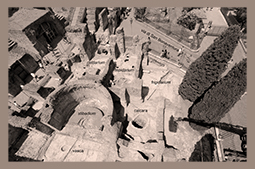download articles as .pdf: Archeologia e architettura nell’area delle “Terme di Elagabalo”, alle pendici nord-orientali del Palatino. Dagli isolati giulio-claudii alla chiesa paleocristiana
.
 At the conclusion of the archaeological investigations into the building complex on the North-East slopes of the Palatine Hill, known in the archaeological literature as “Baths of Elagabalus”, this study clarifies the main building phases of the area, from the Julio-Claudian period to the Late Antiquity and the early Middle Ages. In particular, three building blocks have been examined dating back to the Julio-Claudian age, destroyed by the fire under the empire of Nero in 64 AD, which apparently were not followed by a new building phase. The construction activities started again under Hadrian, when the area was occupied by a new building, probably for commercial activities, with spaces overlooking the street towards the Forum, included in a much larger urban project, which extended between the Temple of Venus and Rome and the monumental substructures of the Palatine. The Hadrianic building had a short life: already in the Severan period it was demolished to be replaced by a new building of still uncertain use , with a large courtyard and many rooms around, and others opened towards the street. In the first half of the fourth century AD, on the ruins of the Severan building, a new edifice was founded characterized by a large peristyle, with pools and fountains inside the columnades, and by a cruciform hall with a masonry stibadium. A well was accessible through a large staircase, and on its bottom a dolium was placed, whose function is still uncertain. In a period that could be probably placed around the Seventh century, the area – then abandoned – was occupied by a small church with a single nave, whose walls reused in the foundations a large amount of marble sculptures, probably decorating the Severan building.
At the conclusion of the archaeological investigations into the building complex on the North-East slopes of the Palatine Hill, known in the archaeological literature as “Baths of Elagabalus”, this study clarifies the main building phases of the area, from the Julio-Claudian period to the Late Antiquity and the early Middle Ages. In particular, three building blocks have been examined dating back to the Julio-Claudian age, destroyed by the fire under the empire of Nero in 64 AD, which apparently were not followed by a new building phase. The construction activities started again under Hadrian, when the area was occupied by a new building, probably for commercial activities, with spaces overlooking the street towards the Forum, included in a much larger urban project, which extended between the Temple of Venus and Rome and the monumental substructures of the Palatine. The Hadrianic building had a short life: already in the Severan period it was demolished to be replaced by a new building of still uncertain use , with a large courtyard and many rooms around, and others opened towards the street. In the first half of the fourth century AD, on the ruins of the Severan building, a new edifice was founded characterized by a large peristyle, with pools and fountains inside the columnades, and by a cruciform hall with a masonry stibadium. A well was accessible through a large staircase, and on its bottom a dolium was placed, whose function is still uncertain. In a period that could be probably placed around the Seventh century, the area – then abandoned – was occupied by a small church with a single nave, whose walls reused in the foundations a large amount of marble sculptures, probably decorating the Severan building.
